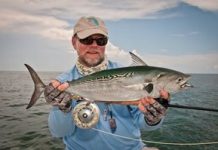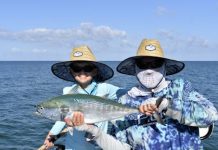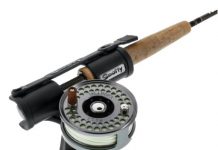By Capt. Pat Damico, CapMel.com Flyfishing Editor
I will gladly admit my favorite fly rod quarry is a mean Old Snook. Daytime Snook fishing with a long rod is hard work. Yes, there are many areas where numbers of small Snook can be tempted during the day, especially during the first and last hours and under low light conditions. If you want to get really rattled and have your tackle tested, fish in the dark. One of my fishing buddies, Bob Finck, told me years ago, after a Snookin’ good trip, “Pat, they’re like largemouth bass on steroids.”
If you’ve never pursued Snook at night, where do you begin? I use a flats boat that is equipped with a bow mounted Minn Kota electric motor. Preferring not to anchor, I can maneuver the boat, even when fishing alone, to get me in the best position. The electric will also be used as soon as you hookup, to get you and your lunker away from barnacle encrusted structure. Use your electric in forward mode only and turn it one hundred and eighty degrees to go in the opposite direction. Reverse prop wash seems to disturb fish because of the excess vibration. A slow steady speed will not scare fish like sudden stopping and starting. Dock lights will be the areas where I will do most of my fishing. These lights attract plankton, which in turn attract hordes of baitfish that are easy pickings for large, lazy Snook. Some bridges have lights on the fenders and lighted Marinas will also attract fish, but I prefer to concentrate on lighted docks. Check out the areas you want to fish during the day so you are familiar with water depth and any navigational hazards. Pick an area where there are a lot of lights mounted close to the water. This way, you can just use your electric to go from one to the next. After a hookup, a light will frequently not produce for a while. Move to the next one and return later. Running and gunning at night is not a good idea. This time of year, docks near passes and points adjacent to deeper water will harbor more fish. As the water temperature drops, docks back in canals where water is warmer will be more productive.
Are tides important? Is incoming preferred over outgoing? The most important consideration is to have moving water. If the tide is slack, the fish will be there milling around and not feeding. Pick times when there is maximum tidal flow. The current will orient the fish. As they face into the current waiting for their food, they may be positioned away from the dock with one tide and under the dock when it reverses.
Tackle will depend on the size of fish available. Two fly rods one with a floating and the second with a clear sink tip would be ideal. Nine-foot, fast action rods in eight or nine weight should be equipped with thirty pound fluorocarbon shock tippets. A nine-foot tapered leader on the floating line is perfect. The sink tip can have a three or four-foot shock tippet only since the clear line is almost invisible. Observing feeding fish will tell you what flies to select. Snook will be very selective. If they are feeding on glass minnows, larger offerings will be refused. When a small grass shrimp skips under the light in a panic followed by a series of explosive boils, use a small shrimp pattern. Duplicate the movement of the forage with your retrieve. Keep the rod tip close to the water and strip strike when you feel the take, then get the fish away from the structure. Crimp the barbs on flies, it will make release easier and help penetration. Besides shrimp and baitfish patterns that sink, I always have a few floating patterns; nothing beats the excitement of a large Snook exploding the surface. The newer synthetic materials are very effective. Polarfiber Minnows, Dan’s Neerly Live Bait, Lefty’s Deceiver and Clouser Minnows are all good choices for sub surface. Jack Garside’s Gurgle Bug and small Poppers will work on top.
Your boat should be well organized and everything unnecessary should be stowed. Daytime problems will quadruple at night. Tripping, catching line, not finding things, can be frustrating. Stealth is the key. Noise should be eliminated. I wear a small “LEDHEDZ” light on my hat brim that uses small button type batteries and weighs almost nothing. It can be turned on to change and locate flies or assist in bringing a fish alongside for release.
Fly line management, especially in the dark, can be a major problem. I’ve caught more than one sixty dollar fly line in my electric motor. A couple weeks ago, Capt. Mel Berman and I were guests of Capt. Rick Grassett, fishing Sarasota Bay. Rick introduced me to a homemade stripping basket that can be placed on the deck and is a clever, inexpensive way to eliminate all the problems associated with fly line control. When not used, it is very compact and easily stored. Contact me if interested in a description of how to make this inexpensive tool. Besides catching fish, this tip alone was worth the trip with Rick.
Remember, you are fishing in someone’s back yard. I make it a policy to thank dock owners when they are around during the day, for the privilege of fishing their dock at night. Not only will this surprise them, I have been given some great other fishing locations nearby.
If your fly fishing luck with daytime Snook has been frustrating, give night fishing a try. Your catching rate should accelerate. When you see the size and numbers of fish after dark, and how much fun you’ve missed, you’ll see why this has become my favorite.
Capt. Pat Damico
St. Pete Beach
727-360-6466
www.captpat.com
- Captain’s Corner:Pat Damico - June 25, 2019
- Flat water makes seeing tarpon easier - May 17, 2017
- Warm rivers holding plenty of targets for fly fishermen - February 16, 2017











